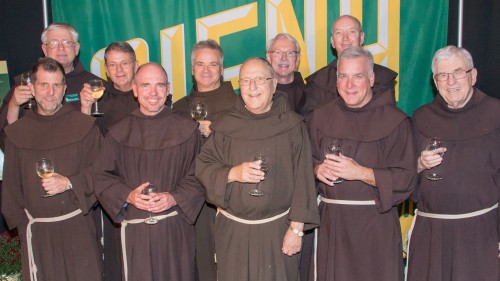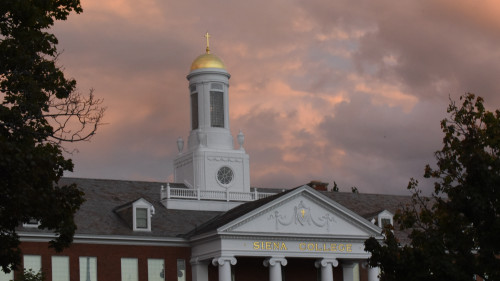
By Delcy Fox
On Friday, January 18, approximately 150 Siena College faculty members, administrators and staff came together for “Education Summit: Planning Siena’s Future.” The Summit grew out of recent Cabinet discussions about articles appearing in the Chronicle of Higher Education and Time magazine (“Reinventing College,” Oct. 29, 2012) concerning the changing landscape for higher ed. Linda Richardson, Ph.D., vice president for academic affairs, and President Fr. Kevin Mullen ’75, O.F.M., Ph.D., invited the Siena community to the Summit to reflect upon Siena’s accomplishments and plan for the future.
“We are at a key moment in the life of the College,” Mullen said in his opening remarks. “We are aware of the challenges that face us. This is a moment when we have come together – our great strength – to listen, to share and to reflect upon our present and future. It is significant that we do this during our 75th year. We are proud of where we have come from and we want to do all within our power to strengthen our present and provide a solid foundation to assist us in the future.”
Mullen went on to describe his expectations for the day and encouraged participants to adopt a large view and examine the College from a strategic vantage point.
“Embrace the vision of what is necessary and what promotes the College as a whole. In other words ‘think Siena,’ what might we do to advance and promote its mission,” Mullen said.
The Summit consisted of five concurrent sessions facilitated by faculty members from all three schools and administrators from every area of the College: Academic Programs, Enrollment, A Different Academic Calendar, Technology Focus Group and Ratings and Classifications. Participants could stay with a session topic all morning or else move from session to session. Facilitators led the discussion and all suggestions were recorded. Some sampling of the matters discussed included an alternative academic year so as to provide for more opportunities for double majors, additional minors, service and perhaps shortening time to graduation and graduate programs that capitalize on Siena’s strengths and retain students for an additional year (e.g., social work or education). Mullen was pleased with how the process went along and reminded the group that the day was the beginning of a dialogue, not the end.
Mullen concluded the Summit by thanking everyone for their participation. He cited Siena’s ability to adapt in the past, from its early years during World War II, to the addition of lay faculty and administrators and the admitting of women.
“Today highlights Siena’s liberal arts roots and Franciscan and Catholic heritage,” Mullen said. “Since its founding in 1937, Siena has responded to the educational needs of the time and adjusted the institution. It’s heartwarming for me to see that the members of this community have the courage to embrace change 75 years later. This will set us on the road to the future. The one word I heard today over and over was ‘quality.’ Siena is a quality place and everyone here is very proud of that. I’d like to express my gratitude to Linda Richardson for bringing us together for the Summit. Siena’s strength is that we’re doing this together. I am grateful for your willingness to participate and I would like to offer my prayers and best wishes for a day that we will look back on as marking a significant moment in the history of Siena.”
Mullen will appoint a Presidential Task Force to continue this important work, with the members of the Task Force to be announced at a later date. He looks forward to working with the Task Force over the course of the Spring semester to advance the ideas put forth. He invites ongoing participation via the online blog where views and opinions may be shared as well as an invitation to share relevant resources and readings that may assist the Task Force and the entire community.



